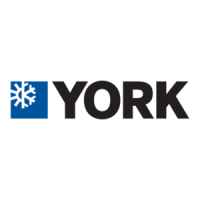
Do you have a question about the York E2FB120 and is the answer not in the manual?
| Refrigerant | R-410A |
|---|---|
| Voltage | 208/230V |
| Phase | 1 |
| Cooling Capacity | 12000 BTU/h |
| Heating Capacity | 12000 BTU/h |
Introduction to the manual's purpose and key sections for installing the unit.
Procedures for inspecting the unit for damage incurred during shipping and transit.
Adherence to national, state, and local safety codes is mandatory.
Guidelines for selecting outdoor unit placement considering noise, accessibility, roof/ground level.
Safe techniques for lifting and moving the unit to prevent damage.
Safe rigging, unit clearances, compressor details, and crankcase heater function.
Instructions for electrical connections, including power supply and control circuits.
Table of electrical specifications including voltage, current, and fuse sizes.
Guidelines for selecting appropriate control wiring gauge to ensure proper voltage.
Best practices for ensuring an internally clean and dry refrigerant system.
Visual representation and specific measurements for unit dimensions and clearances.
Factors and tables for correctly sizing liquid and vapor refrigerant lines.
Guidelines on liquid line pressure drop, vertical rise, and preventing refrigerant flashing.
Advice on vapor line sizing for oil return and friction loss, including trap requirements.
Information on the function and operation of the unit's service valves for maintenance.
Step-by-step instructions for extending service ports for easier access during service.
Table detailing the amount of refrigerant charge per foot for liquid and vapor lines.
Detailed steps for connecting refrigerant lines, including brazing and nitrogen purging.
Procedures for evacuating the system to 500 microns and charging refrigerant.
Alternative methods for charging refrigerant based on ambient temperature conditions.
Factors influencing the balance point and references for calculation.
Diagram illustrating refrigerant flow during cooling and heating cycles.
Graph showing suction and discharge pressure relationships for EFB090 model.
Graph showing suction and discharge pressure relationships for EFB120 model.
Detailed sequence of operations for the cooling mode, including safety lockouts.
Detailed sequence of operations for the heating mode, including safety lockouts.
Explanation of how and when the defrost cycle is initiated and terminated.
Specific operational considerations and safety features for sub-zero outdoor temperatures.
How the system operates when switched to the emergency heat mode.
Comprehensive pre-start checks and step-by-step initial start-up procedures.
Crankcase heater requirement and overview of built-in safety protections.
Advice on cleaning, lubrication, parts, and basic owner troubleshooting.
